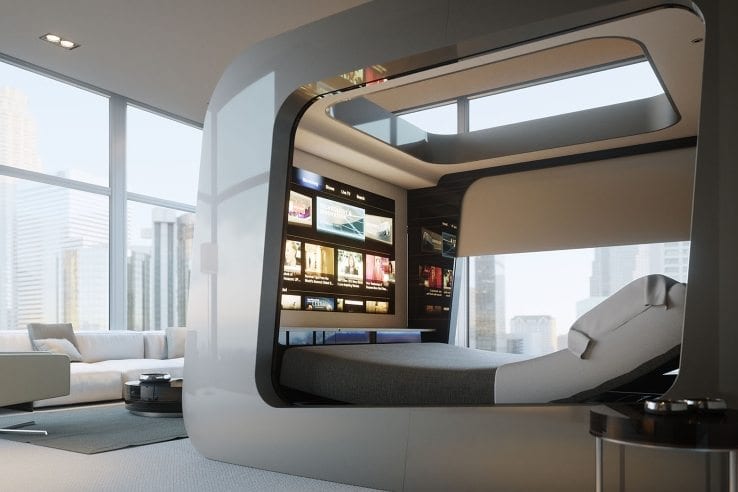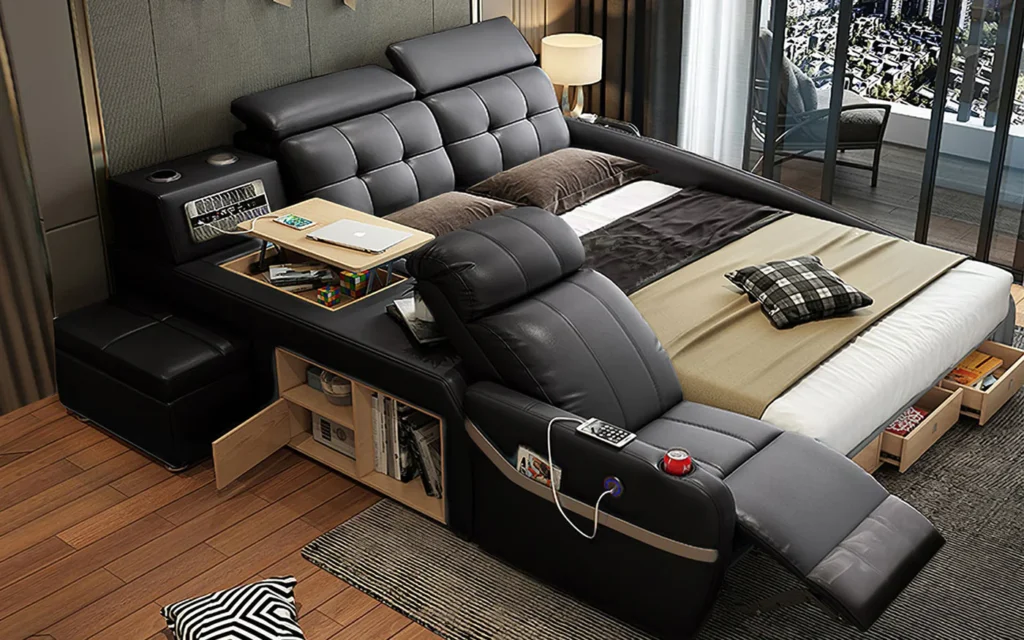In today’s fast-paced world, where time is a precious commodity, the importance of quality sleep often takes a backseat. Despite growing awareness of its significance, innovative solutions have become increasingly sought after. Yet, amidst this quest, a silent revolution has emerged in the form of adjustable smart beds, fundamentally altering our approach to sleep. Beyond merely a place to rest, these beds offer something revolutionary: a tailored sleep experience, unique to individual comfort needs. This comprehensive guide delves into the realm of sleep technology, unveiling the wonders of customizable comfort and its profound impact on our lives. Come along as we embark on this journey to discover the secrets behind a personalized, rejuvenating sleep experience.
Evolution of Sleeping Technology

Over time, the concept of the traditional bed has evolved into a sophisticated piece of technology that enhances comfort and sleep quality. This transformation has shifted the focus from mere resting furniture to sophisticated sleep solutions. Adjustable smart beds have redefined comfort and functionality, offering users a customizable sleep experience tailored to their preferences. This progress signifies a shift from conventional mattresses to technologically enhanced beds, allowing individuals to explore various sleep positions and find optimal comfort. Such advancements have paved the way for a new era in the domain of sleep technology.
Features of Adjustable Smart Beds
1. Wireless Remote Control
– Adjustable beds typically come with a wireless remote control that enables users to adjust settings with ease. The intuitive design of the remote facilitates a user-friendly experience.
2. Smart Connectivity
– Integrating with smart home ecosystems, these beds can be controlled via smartphones or voice commands. This connectivity adds a layer of convenience, allowing users to adjust settings without leaving the comfort of their beds.
3. Massage and Relaxation Features
– Many adjustable smart beds come with built-in massage functions, providing a therapeutic experience. These features can help relieve muscle tension and promote relaxation, enhancing the overall sleep quality.
4. Sleep Tracking Technology
– Some advanced models incorporate sleep tracking technology. Sensors monitor sleep patterns, offering insights into sleep duration, interruptions, and overall sleep quality. This data empowers users to make informed decisions for better sleep hygiene.
5. Zero Gravity Position
– Some adjustable beds offer a Zero Gravity position, inspired by NASA technology. This position elevates the legs and head to align the body in a neutral posture, promoting weight distribution and reducing pressure on the spine.
Benefits of Adjustable Smart Beds
1. Customized Sleep Positions
– One of the primary benefits of adjustable smart beds is the ability to customize sleep positions. Users can elevate their upper body or legs, catering to individual preferences and providing a personalized sleep experience.
2. Improved Comfort and Support
– The flexibility of adjusting bed positions allows users to find the optimal alignment for their spine, reducing pressure points and promoting overall comfort. This can be especially beneficial for individuals with back pain or discomfort.
3. Alleviation of Sleep Disorders
– Adjustable beds can help alleviate symptoms of sleep disorders such as snoring and sleep apnea. Elevating the upper body can open airways, reducing snoring, while specific positions can assist in managing sleep apnea symptoms.
4. Enhanced Circulation
– By adjusting the bed to elevate the legs, users can enhance blood circulation. This is particularly valuable for individuals with conditions like edema or those looking to prevent circulatory issues.
5. Reduction of Acid Reflux Symptoms
– Adjustable beds with the ability to elevate the upper body can help reduce symptoms of acid reflux. This elevated position can prevent stomach acid from flowing back into the esophagus, providing relief for individuals prone to acid reflux.
6. Versatility for Different Activities
– Beyond sleep, adjustable smart beds offer versatility for various activities. Whether it’s reading, watching TV, or working on a laptop, the flexibility of adjusting the bed’s position ensures comfort in a range of situations.
7. Potential Reduction in Snoring
– Elevating the upper body can contribute to reducing snoring by keeping the airways open. This can be beneficial not only for the snorer but also for their sleep partner.
8. Relieving Pressure Points
– The ability to customize the bed’s position helps distribute body weight evenly, reducing pressure points. This can be particularly valuable for individuals with conditions such as arthritis or joint pain.
Choosing the Right Adjustable Smart Bed
1. Identify Your Needs
– Assess your specific requirements. Do you need relief from back pain, want a massage feature, or are you looking for a bed with sleep-tracking capabilities? Understanding your needs will guide your choice.
2. Research Brands and Models
– Explore reputable brands and models in the market. Read reviews, customer feedback, and expert opinions to gauge the overall satisfaction and performance of different adjustable smart beds.
3. Budget Consideration
– Determine your budget range. Adjustable smart beds come in various price points, so it’s essential to find a balance between features and affordability. Consider any additional costs, such as extended warranties or delivery fees.
4. Test the Bed
– If possible, try out the adjustable bed in a showroom or through a demo. Assess the ease of use, noise levels during adjustments, and the overall comfort in different positions.
5. Customization Options
– Look for a bed that offers a wide range of customization options. Check if it caters to your preferred sleep positions, has adjustable lumbar support, and provides various massage intensities if that’s a feature you desire.
6. Smart Connectivity
– Ensure the bed integrates seamlessly with your smart home ecosystem if you value smart connectivity. Check compatibility with your devices and the ease of controlling the bed through apps or voice commands.
7. Warranty and Customer Support
– Investigate the warranty offered by the manufacturer. A longer warranty period can be an indicator of the bed’s durability. Additionally, inquire about customer support options in case you encounter issues or have questions.
8. Size and Compatibility
– Confirm that the adjustable bed is available in the size you need and is compatible with your existing mattress or a mattress of your choice. Some beds are designed to fit within existing bed frames.
9. Additional Features
– Consider any extra features that align with your preferences, such as under-bed lighting, USB charging ports, or specific sleep-enhancing technologies.
10. Return Policy
– Check the manufacturer’s return policy. This is particularly important if you’re purchasing online. Knowing the return conditions can provide peace of mind in case the bed doesn’t meet your expectations.
11. Long-Term Considerations
– Think about your long-term needs. Adjustable smart beds are an investment, so consider factors like future lifestyle changes, potential health issues, or the adaptability of the bed over time.
12. Energy Efficiency
– Assess the energy efficiency of the adjustable bed, especially if it includes features like massage functions or smart connectivity. Look for energy-saving options to reduce long-term operational costs.
Impact of Adjustable Smart Beds on Sleep Disorders
1. Sleep Apnea
– Adjustable beds, especially those with an anti-snore feature, can be beneficial for individuals with sleep apnea. Elevating the upper body helps keep airways open, reducing the likelihood of snoring and potentially minimizing sleep apnea symptoms.
2. Snoring
– The ability to customize sleep positions, including elevating the head, can significantly reduce snoring. Adjustable beds provide individuals prone to snoring with an effective solution that contributes to a quieter and more restful sleep environment.
3. Acid Reflux and GERD
– Elevating the upper body can help prevent stomach acid from flowing back into the esophagus, providing relief for individuals with acid reflux or gastroesophageal reflux disease (GERD). Adjustable beds offer a comfortable solution for managing these conditions during sleep.
4. Insomnia
– Customizable sleep positions and features such as massage functions contribute to relaxation, potentially alleviating symptoms of insomnia. The personalized comfort provided by adjustable beds can create a conducive environment for falling and staying asleep.
5. Restless Leg Syndrome (RLS)
– For individuals with Restless Leg Syndrome, finding a comfortable sleep position is crucial. Adjustable beds allow users to customize leg elevation, potentially reducing discomfort associated with RLS and promoting better sleep quality.
6. Back Pain
– Adjustable beds offer targeted support for individuals with back pain. Customizable positions help align the spine, reduce pressure on the lower back, and alleviate discomfort. This can be especially beneficial for those with chronic back pain issues.
7. Circulatory Issues
– Elevating the legs on adjustable beds can enhance blood circulation, addressing issues related to poor circulation. This is valuable for individuals dealing with conditions like edema or those seeking preventative measures against circulatory problems.
8. Fibromyalgia and Chronic Pain
– The ability to adjust the bed to find the most comfortable position is particularly important for individuals with fibromyalgia or chronic pain conditions. Adjustable beds provide flexibility to accommodate changing pain levels and enhance overall sleep comfort.
9. Chronic Fatigue Syndrome
– Improved sleep quality facilitated by adjustable beds may contribute to managing symptoms of chronic fatigue syndrome. The customization options allow users to create an environment that supports restorative sleep.
10. Post-Surgery Recovery
– Adjustable beds can be beneficial for individuals recovering from surgery. The ability to customize sleep positions helps minimize strain on incisions or affected areas, promoting a more comfortable and supportive recovery environment.
Also Read: Interactive Coffee Tables with Smart Tech Integration
In conclusion, the advent of adjustable smart beds marks a significant stride in the pursuit of optimal sleep quality. These innovative sleep solutions, with their customizable features and smart technologies, cater to the diverse needs of individuals, offering a personalized sleep experience like never before. The ability to tailor sleep positions, integrate massage functions, and track sleep patterns not only fosters comfort but also empowers users to make informed decisions for better sleep hygiene. As technology continues to advance, the future of adjustable smart beds holds exciting possibilities. With the integration of AI, enhanced health tracking, and further innovations, these beds are poised to further revolutionize our sleep experiences. Adjustable smart beds aren’t just about a good night’s sleep; they represent a holistic approach to wellness, prioritizing comfort and health to ensure that every night’s rest is a step toward a more revitalized, healthier life.
